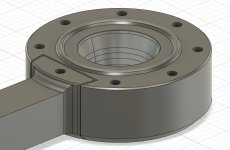Almost done (a new, true constant-directivity waveguide)...


I only need to think through the kit.
BTW, this is the current Gen2 approach:

I only need to think through the kit.
BTW, this is the current Gen2 approach:
Stop it! ;-D
I suppose it's not constant until the snakes are equally fat from 800-20k 🙂
//
I suppose it's not constant until the snakes are equally fat from 800-20k 🙂
//
Could be a typo, though they also emphasize it in the list of features: "Extended low frequency to 1200Hz".It would be interesting to know how they actually specify this / determine the number (if it's not a typo).
I'm not a magician 🙂I suppose it's not constant until the snakes are equally fat from 800-20k 🙂
800-20k would need a 575mm waveguide with 19mm throat. Possible with the right driver, I guess. Worth going that far? I'm not so sure.
This is 1".A460F would be for 1" or 1.4" driver?
- Even now it's not perfectly flat, but close:
Last edited:
The lower 800 was not the main point but I reacted to "true constant" which if really true, would look like:

or even:

Picky... yes - but I suppose correct!?
//
or even:
Picky... yes - but I suppose correct!?
//
Last edited:
I don't know whether correct but certainly impossible. To me constant directivity means basically a flat DI.
The examples you show would have a flat DI, that's for sure.
The examples you show would have a flat DI, that's for sure.
Last edited:
The point is that the very far off-axis polars (the tilted ones) don't contribute to the total radiated power a lot in the end, as they are so weak.
- As you can see, the SP curve is already closer to being flat than the FR at 45deg.

(Just another way how to present the same data.)
- As you can see, the SP curve is already closer to being flat than the FR at 45deg.
(Just another way how to present the same data.)
Last edited:
I could be wrong, but I'm fairly certain that flat normalized frequency response at all angles in free space is a physical impossibility with any real waveguide due to diffraction at the mouth (unavoidable as the termination must be finite). Practically speaking, constant directivity means a flat or nearly flat DI with reasonably flat individual responses out to at least the effective coverage angle.Picky... yes - but I suppose correct!?
...which is typically the only way how to get a flat DI anyway. Hard to imagine it otherwise.with reasonably flat individual responses out to at least the effective coverage angle
800-20k would need a 575mm waveguide with 19mm throat. Possible with the right driver, I guess. Worth going that far? I'm not so sure.
Sounds like a nice project I would love to build over the Christmas holidays, if you actually design such a waveguide.
Poorly terminated devices don't tend to have "reasonably flat individual responses" by my definition, but can have a pretty flat DI. It's true that any good design would meet the criterion, so I suppose it's mostly superfluous....which is typically the only way how to get a flat DI anyway. Hard to imagine it otherwise.
Really? 🙂Sounds like a nice project I would love to build over the Christmas holidays, if you actually design such a waveguide.
It would definitely mean a ring plug and a suitable compression driver (which even reaches that high), maybe with an extended throat. And would very probably end up with DSP as necessity.
Hi,Almost done (a new, true constant-directivity waveguide)...
View attachment 1367095View attachment 1367092
I only need to think through the kit.
BTW, this is the current Gen2 approach:
View attachment 1367097
cool, do you have a plan for it, like whether something like this becomes available for 1.4" drivers, perhaps the whole gamut of adapters like the ND3x? And what kind of a schedule you have with this project, released roughly within a month or perhaps later?
Really? 🙂
It would definitely mean a ring plug and a suitable compression driver (which even reaches that high), maybe with an extended throat. And would very probably end up with DSP as necessity.
If a suitable compression driver exists, it would sounds like a fun project. Otherwise I go for the already purchased 520G2. I want to use anyway a miniDSP FLEX as a crossover, so DSP is not an issue. Bass driver will (probably) be a SB Acoustics SB34NRXL75-8 in a sealed enclosure.
I'm testing a new 1" adapter, and this is a direct comparison of Peerless DFM-2535 (blue) and B&C DH450, under same conditions.
It gives yet a bit different perspective as to what the frequency limits of the drivers actually are.

The DFM-2535 is considerably cleaner above 6 kHz though.
It gives yet a bit different perspective as to what the frequency limits of the drivers actually are.
The DFM-2535 is considerably cleaner above 6 kHz though.
- Home
- Loudspeakers
- Multi-Way
- Acoustic Horn Design – The Easy Way (Ath4)
